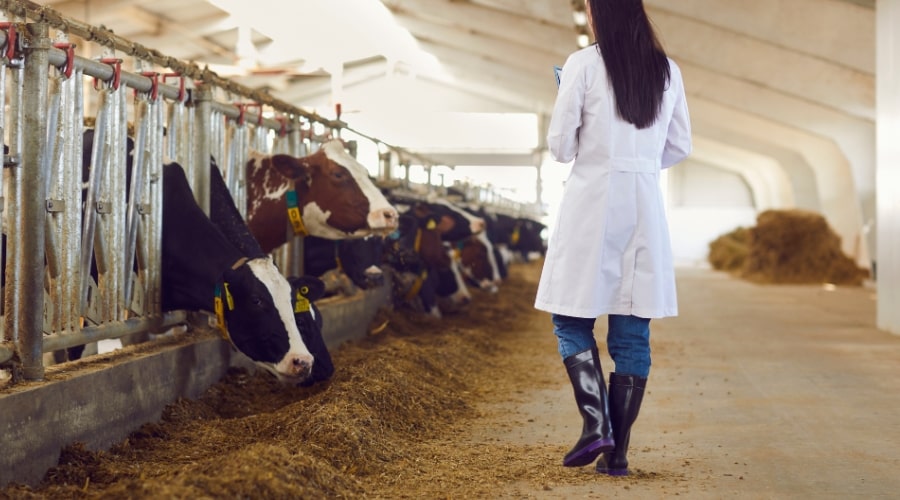Running a successful dairy farm requires careful attention to factors affecting production. Avoiding common mistakes helps ensure higher productivity and healthier livestock. Here are the key mistakes to watch out for.
Inadequate Nutrition Management
Providing poor-quality feed or failing to meet nutritional needs is a major mistake. Dairy cows need a balanced diet rich in protein, energy, vitamins, and minerals. Without proper nutrition, milk production drops, and herd health suffers.
Ignoring forage quality is another issue. Poorly stored silage or hay can develop mold or lose nutrients, affecting milk yield. Test your forage regularly to ensure its quality. Adjust feeding strategies based on the nutritional requirements of different lactation stages.
Failing to provide clean, fresh water is equally detrimental. Cows require 30 to 50 gallons of water daily for optimal milk production [TO BE VERIFIED]. Dehydration directly reduces milk output.
Overcrowding and Poor Housing Conditions
Overcrowding leads to stress, which reduces milk production. Ensure each cow has adequate space to move and lie down comfortably. Follow guidelines for stocking density to avoid overcrowding.
Ignoring ventilation and cleanliness can cause respiratory problems and infections. Proper airflow reduces heat stress in summer and maintains air quality year-round. Keep bedding clean and dry to prevent mastitis and other infections.
Failing to provide adequate shelter for extreme weather is another mistake. Protect cows from excessive heat, cold, and rain to minimize stress and energy loss.
Poor Reproductive Management
Neglecting reproductive health impacts milk production cycles. Long calving intervals reduce the time cows spend in peak lactation. Aim for a calving interval of 12 to 14 months [TO BE VERIFIED].
Failing to detect heat cycles on time leads to missed breeding opportunities. Use heat detection tools like tail chalks or activity monitors. Ensure timely artificial insemination or natural breeding for consistent reproduction.
Not maintaining proper records of breeding history can lead to inefficiencies. Track each cow’s reproductive performance and adjust management strategies accordingly.
Ignoring Herd Health
Overlooking regular health check-ups increases the risk of diseases spreading. Mastitis, for example, can severely affect milk quality and yield. Regularly inspect udders for signs of infection and treat issues promptly.
Failing to vaccinate and deworm on schedule compromises herd immunity. Work with a veterinarian to create a health plan tailored to your farm’s needs. Keep detailed records of vaccinations and treatments.
Lameness is another overlooked issue. Cows with hoof problems consume less feed, reducing milk production. Schedule regular hoof trimming and provide dry, non-slippery surfaces.
Inconsistent Milking Practices
Inconsistent or improper milking routines negatively affect milk yield. Stick to a regular milking schedule to avoid stressing the cows. Use clean, well-maintained milking equipment to prevent infections and contamination.
Rushing the milking process can cause incomplete milk extraction, leading to reduced yield. Ensure milking machines are correctly adjusted and handle cows gently during the process. Train workers in proper milking techniques.
Neglecting to monitor milk quality is another mistake. Test milk regularly for somatic cell counts and bacterial levels. High counts indicate infections or poor hygiene, which need immediate attention.
Poor Financial Planning
Underestimating costs is a common mistake. Failing to budget for feed, health care, labor, and equipment maintenance can lead to cash flow problems. Create a detailed budget and update it regularly based on market conditions.
Not keeping records of expenses and revenues hampers decision-making. Use herd management software or spreadsheets to track financial data. This helps identify areas where costs can be reduced or profits increased.
Ignoring market trends and customer preferences can result in lost opportunities. Stay informed about demand for milk types, such as organic or high-butterfat products, to adjust your operations accordingly.
Checklist for Avoiding Dairy Farming Mistakes
- Provide balanced, high-quality nutrition and clean water.
- Maintain proper housing with adequate space and ventilation.
- Manage reproduction effectively to maintain consistent calving intervals.
- Schedule regular health check-ups, vaccinations, and hoof care.
- Stick to a consistent milking routine with clean equipment.
- Create a detailed budget and track financial records.
- Monitor market trends and adapt operations to meet demand.
By addressing these common mistakes, you can improve dairy production and create a more efficient farming operation. Small adjustments make a big difference when consistently applied.


